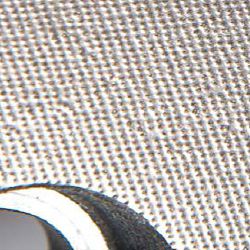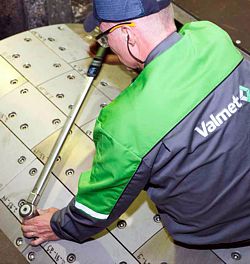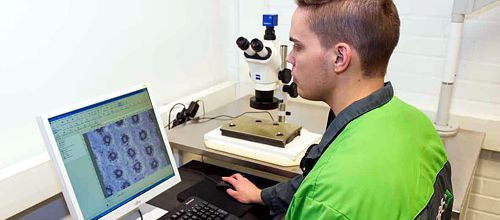Save energy in grinding with Valmet Grinding Services Galileo
Oct 9, 2018
Background of diamond grinding development

Dual research projects
Research at Tampere University of Technology looked at the effects of waves on an electroplated diamond surface, because this would result in lower load frequencies, preparing the wood for grinding. Valmet started working with Åbo Akademi University and paper manufacturers to study the impact of the shape and size distribution of the grinding particles. These studies were conducted on single-layer surfaces where the grinding grains were attached in a predefined layout and fixed by brazing technology.
Grinding with brazed diamond segments
The results were promising, and Valmet partnered with other researchers and paper manufacturers to commercialize the concept. This research including multiple pilot studies at Valmet’s Inkeroinen technology center. The concept proved to be energy-saving and improved pulp quality. But the key mill-scale drivers were surface durability and precise control of surface characteristics, as well as how the technology could be adapted to existing GW (groundwood) and PGW (pressurized groundwood) machines. Due to these factors, the surface production technology based on brazing was chosen. Since the production technology was not ready for large grinding surfaces, Valmet took the initiative to develop the manufacturing technology, brazing materials and machinery for mill-scale use.
Galileo technology is born

Precision
The required precision of brazed diamond surfaces is in the tens of micrometers on large surface areas. Maintaining this level of precision in such a demanding environment was one of the biggest challenges of the Galileo project.
Surface endurance
The grinding process environment is demanding. The surfaces must be able to withstand 24/7 wear and corrosion for a long period of time, up to 12 months.
Long run times
The diamond coated surfaces must grind more than half a million kilometers on wood under heavy loads, ideally with consistent quality and energy consumption. Valmet has achieved extraordinary long running times while maintaining uniform end-product quality and low shive levels. Great results have been measured with six-month running periods, but Galileo surfaces can last up to a year in some applications (unfortunately, not even diamonds last forever).
Significant reduction in energy consumption
With Galileo grinding technology, reductions in energy consumption can reach up to 300–500 kWh per tonne, equivalent to annual cost savings of over 500,000 EUR. The business model ranges from conventional purchase to a lease option, and the payments are based on realized production and actual savings.
Valmet uses a remote access system to easily monitor the grinding processes and Galileo’s performance. The follow-up of the performance is essential when the targets are set high. With continuous monitoring of the SEC and pulp quality, we can maintain the performance of each surface at its peak. This way, the customer is sure to never pay for more than they have saved and can only win.

Grinding surface patterns are engineered to individual customer processes.
Win-win benefits for pulp mills
With the diamond coated surface, mills can improve both energy efficiency and production of the grinder. A key parameter in tailoring Galileo to meet the energy saving and pulp quality requirements is the precise placement of each diamond in its desired position. With the ever-growing number of surface patterns engineered to individual customer processes, Valmet can bring the desired benefits, including:
- Production cost saving of 20 EUR/ton
- Increased pulp production of 25-100%
- Improved fiber quality, especially reduced quality variation (-50%)
Contact your Valmet representative for more information about lowering your energy costs, increasing your pulp production and improving your fiber quality.